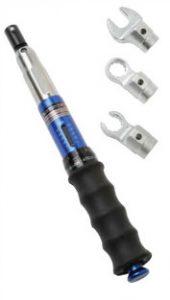Establishing a Quality Torque Program
Experience, Quality and Reliable
 In the manufacturing and assembly world, tightening, controlling, or measuring Torque fasteners is imperative for production efficiency. An inadequately torqued fastener can vibrate or work loose: conversely, if the tension is too high, the fastener can snap or strip its threads. Faced with these problems, manufacturers are realizing that precise Torque control can spell the difference between a safe, reliable, and economical product and complete disaster.
In the manufacturing and assembly world, tightening, controlling, or measuring Torque fasteners is imperative for production efficiency. An inadequately torqued fastener can vibrate or work loose: conversely, if the tension is too high, the fastener can snap or strip its threads. Faced with these problems, manufacturers are realizing that precise Torque control can spell the difference between a safe, reliable, and economical product and complete disaster.
Anybody who has to tighten a threaded fastener and needs to control, monitor, or measure torque needs sophisticated torque tools. If manufacturers want to save money, make their workplace safer, enhance product quality, or reduce their exposure to liability; only specialized high-quality torque tools will get the job done properly.
1. Pick the Right Torque Tool
A wide variety of torque tools are available to control or measure the torque applied to fasteners, from electric screwdrivers to large industrial Torque Wrenches, Torque Analyzers, Torque Sensors, and torque multipliers. These tools utilize calibrated torque setting mechanisms that may be factory pre-set or user-definable. When the specified setting is reached, the tool gives a visual, audible, or tactile signal. The anticipated production output, the type of materials being joined, the amount of torque required, and the specified fasteners determine the selection of tools for a given application. Lighter materials such as wood or plastic may require only lightweight tools; likewise, heavy materials such as steel may require stronger or larger tools. If torque data must be gathered during the assembly process or quality process, tools should also have connection ports such as USB, RS-232 and other cabling connections.
2. Establish a Torque Calibration Program
 Calibration is fine-tuning the torque control process in a production environment. Torque Calibration should be checked periodically to determine whether torque tools are operating at their proper settings. Many tools don’t have a locking device, and users may easily change their torque settings. When this happens, the tool falls out of adjustment.
Calibration is fine-tuning the torque control process in a production environment. Torque Calibration should be checked periodically to determine whether torque tools are operating at their proper settings. Many tools don’t have a locking device, and users may easily change their torque settings. When this happens, the tool falls out of adjustment.
A regularly scheduled calibration program enables quality control personnel to correct divergence from proper settings, whether it’s because of normal slippage over time or because of adjustments to the tool. Begin by setting a calibration interval initially based on severity of the application and the tool manufacturer’s recommendations. If the applied torque values are out of range, cut the calibration interval in half and re-test the tools.
3. Preventive Maintenance
To maintain consistent accuracy, torque tools must be checked periodically for wear or defective parts. A properly structured preventive maintenance program optimizes tool performance and reduces unexpected downtime, thereby saving time and money in the long run.
Monitoring the number of cycles per day and total hours that a tool is used is the most accurate way to establish proper maintenance intervals. It is recommended that tools be serviced after 100,000 cycles, or if an inspection reveals old or dry grease, parts that show signs of excessive wear, or loose screws and bolts.
4. Use Torque Testers
 Effective use of a Torque Tester is a fast and reliable method of calibrating torque tools to their proper settings. Torque Analyzers can also be used for quick tests on the line or in the lab to determine whether torque tools are holding a given setting. They also allow quality control inspectors to calibrate Torque Sensors and verify torque on fasteners. A quality torque analyzer should have enough memory to record several hundred readings, and it should store calibration data for multiple torque transducers.
Effective use of a Torque Tester is a fast and reliable method of calibrating torque tools to their proper settings. Torque Analyzers can also be used for quick tests on the line or in the lab to determine whether torque tools are holding a given setting. They also allow quality control inspectors to calibrate Torque Sensors and verify torque on fasteners. A quality torque analyzer should have enough memory to record several hundred readings, and it should store calibration data for multiple torque transducers.
Source by: Mountz
